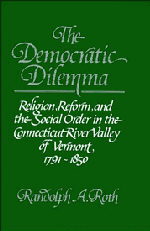 The Democratic Dilemma
The Democratic Dilemma Book contents
- Frontmatter
- Contents
- List of tables and maps
- Acknowledgments
- Introduction
- 1 The revolutionary frontier, 1763–1800
- 2 The failure of the covenanted community and the standing order, 1791–1815
- 3 Religion and reform in the shaping of a new order, 1815–1828
- 4 From an era of promise to pressing times, 1815–1843
- 5 A clamor for reform, 1828–1835
- 6 The great revival, 1827–1843
- 7 A modified order in town life and politics, 1835–1850
- 8 Boosterism, sentiment, free soil, and the preservation of a Christian, reformed republic
- Conclusion: Religion, reform, and the problem of order in the Age of Democratic Revolution
- Appendix A Church records
- Appendix B Types of towns
- Appendix C Occupational groups
- Appendix D Statistical methods
- Notes
- Index
6 - The great revival, 1827–1843
Published online by Cambridge University Press: 04 August 2010
- Frontmatter
- Contents
- List of tables and maps
- Acknowledgments
- Introduction
- 1 The revolutionary frontier, 1763–1800
- 2 The failure of the covenanted community and the standing order, 1791–1815
- 3 Religion and reform in the shaping of a new order, 1815–1828
- 4 From an era of promise to pressing times, 1815–1843
- 5 A clamor for reform, 1828–1835
- 6 The great revival, 1827–1843
- 7 A modified order in town life and politics, 1835–1850
- 8 Boosterism, sentiment, free soil, and the preservation of a Christian, reformed republic
- Conclusion: Religion, reform, and the problem of order in the Age of Democratic Revolution
- Appendix A Church records
- Appendix B Types of towns
- Appendix C Occupational groups
- Appendix D Statistical methods
- Notes
- Index
Summary
A man who called himself Plain Dealer wrote to the North Star of Danville in 1830 to point out ominous parallels between the spiritual condition of Vermont and that of Israel at the time of the prophet Ezekiel. He saw a “great declension of religion” behind the manifold threats to the “peace and prosperity” of the valley. The causes of that declension were not clear to him, but he was certain of the cure: a revival of religion. That alone, he wrote, could heal “the contentions and divisions among us.”
Most Christians shared Plain Dealer's belief that the political and social discord in the valley had its roots in a widespread indifference to God. They had faith in the restorative power of religion and had begun to think the only hope for the valley lay in a revival. But if a revival came, would it be genuine? Would it regenerate the souls of those it touched, sanctify their behavior, and restore the valley to God's grace? Would it restore prosperity, political unity, and sound morals?
To the delight of most Christians, what appeared to be a genuine revival began, albeit modestly, in 1827. It produced dramatic effects. By its end in 1843, at least 43 percent of adult men and women in the valley were full church members, and the vast majority attended church regularly.
- Type
- Chapter
- Information
- The Democratic DilemmaReligion, Reform, and the Social Order in the Connecticut River Valley of Vermont, 1791–1850, pp. 187 - 219Publisher: Cambridge University PressPrint publication year: 1987


